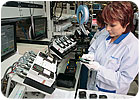
How does a product get a reputation for poor reliability? It starts when management looks to cut costs, writes Keki R. Bhote, in his book World Class Reliability, published in 2004 by the American Management Association. To comply, design engineers specify cheaper parts-which get stressed to their limits-instead of more expensive parts, which handle stress better.
This is short-sighted, says Bhote, who worked 42 years as an engineer with Motorola Inc. and is now president of his own eponymous consulting firm in Glencoe, IL. High-reliability components may be more expensive initially, but they’re far less expensive in the long run than field failures, which cost a company dearly when warranty claims, lawsuits, and the loss of referrals and repeat business are factored in.
To ensure reliability, all parts of an assembly should be derated for stresses such as temperature, vibration and voltage. In other words, they should be stressed so low that they last a long time. As a rule of thumb, mechanical parts should be derated 50 percent, while electrical parts should be derated 40 percent.
Of all the stresses that reduce reliability, heat is the worst, because it accelerates the physics of failure. Infrared scanning is a good way to detect areas of an assembly that get hot, says Bhote. Once these areas are identified, engineers can change the layout or install heat sinks to dispel heat.
Modular designs also improve product reliability. Modularity helps engineers diagnose the cause of breakdowns, and it speeds up the process of stress testing. It also enables design work on the overall product to be completed by teams working in parallel, rather than in sequence.
Another prerequisite for improving reliability is to minimize variation in assembly processes. The higher the defect rate in manufacturing, warns Bhote, the higher the failure rate in the field, and no assembler can afford a process with a Cpk of less than 2. The Cpk, or process capability index, measures the ability of a process to create product within specification limits. It represents the difference between the actual process average and the closest specification limit divided by the standard deviation times three. When the Cpk is less than 1, the process is incapable of producing an assembly within specification limits. When the Cpk is greater than or equal to 1, the process is capable, but not perfect. A world-class assembly process will have a Cpk of 2.
Once an assembly leaves the line, it is subject to uncontrollable factors that adversely affect its reliability. Such factors include heat, cold, humidity, static electricity, voltage fluctuations, misuse and poor maintenance. Using Design of Experiments methodology, engineers can identify these factors and design the assembly to withstand their impact.
Another way to learn more about the reliability of an assembly is through destructive physical analysis, says Bhote. Once a week or once a month, engineers should pull one or two subassemblies from suppliers and take them apart to look for design flaws and substandard manufacturing practices.
If destructive physical analysis is the first line of defense in product reliability, the second is field escape control, a system for examining assemblies that fail functional testing at the end of the line. Assemblies that fail a functional test are separated into two groups: quality-related failures that are unlikely to be passed to the field, and reliability-related failures that are likely to be repeated in the field. If there are two or more reliability-related failures for each failure mode per day, this should be treated as an emergency, and failure analysis should be conducted immediately.
Next month, we’ll discuss Bhote’s method for identifying the weak links in an assembly: multiple environmental overstress testing.






